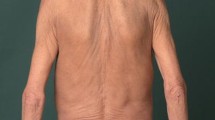Abstract
Management of chronic pruritus in elderly patients requires an understanding of the potential pathophysiological causes. Chronic itch may be caused by xerosis, immunosenescence, neuropathy, skin diseases, systemic illnesses and psychogenic conditions. Several topical, systemic and psychological treatments are available. An individualized treatment approach should be adopted, taking into account the presence of polypharmacy, co-morbidities, physical and cognitive limitations, as well as the potential risk of adverse effects.

Similar content being viewed by others
References
Valdes-Rodriguez R, Stull C, Yosipovitch G. Chronic pruritus in the elderly: pathophysiology, diagnosis and management. Drugs Aging. 2015;32(3):201–15.
Chinniah N, Gupta M. Pruritus in the elderly: a guide to assessment and management. Aust Fam Physician. 2014;43(10):710–3.
Berger TG, Shive M, Harper GM. Pruritus in the older patient: a clinical review. JAMA. 2013;310(22):2443–50.
Berger TG, Steinhoff M. Pruritus in elderly patients: eruptions of senescence. Semin Cutan Med Surg. 2011;30(2):113–7.
Reich A, Ständer S, Szepietowski JC. Pruritus in the elderly. Clin Dermatol. 2011;29:15–23.
Yosipovitch G. Dry skin and impairment of barrier function associated with itch: new insights. Int J Cosmet Sci. 2004;26(1):1–7.
Long CC, Marks R. Stratum corneum changes in patients with senile pruritus. J Am Acad Dermatol. 1992;27(4):560–4.
Jensen JM, Forl M, Winoto-Morbach S, et al. Acid and neutral sphingomyelinase, ceramide synthase, and acid ceramidase activities in cutaneous aging. Exp Dermatol. 2005;14(8):609–18.
Stumpf A, Ständer S. Neuropathic itch: diagnosis and management. Dermatol Ther. 2013;26(2):104–9.
Yosipovitch G, Samuel LS. Neuropathic and psychogenic itch. Dermatol Ther. 2008;21(1):32–41.
Valdes-Rodriguez R, Mollanazar NK, Gonzalez-Muro J, et al. Itch prevalence and characteristics in a Hispanic geriatric population: a comprehensive study using a standardized itch questionnaire. Acta Derm Venereol. 2015;95(4):417–21.
Reich A, Ständer S, Szepietowski JC. Drug-induced pruritus: a review. Acta Derm Venereol. 2009;89(3):236–44.
Yosipovitch G, Bernhard JD. Clinical practice: chronic pruritus. N Engl J Med. 2013;368(17):1625–34.
Weisshaar E, Weiss M, Mettang T, et al. Paraneoplastic itch: an expert position statement of the Special Interest Group (SIG) of the International Forum on the Study of Itch (IFSI). Acta Derm Venereol. 2015;95(3):261–5.
Weisshaar E. Intractable chronic pruritus in a 67-year-old man. Acta Derm Venereol. 2008;88(5):488–90.
Endo JO, Wong JW, Norman RA, Geriatric dermatology: part I. Geriatric pharmacology for the dermatologist. J Am Acad Dermatol. 2013;68(4):521.e1–10.
Kim KH, Lee MS, Choi SM. Acupuncture for treating uremic pruritus in patients with end-stage renal disease: a systematic review. J Pain Symptom Manag. 2010;40(1):117–25.
Patel T, Yosipovitch G. The management of chronic pruritus in the elderly. Skin Therapy Lett. 2010;15(8):5–9.
Disclosure
This article was adapted from Drugs and Aging 2015;32(3):201–15 [1] by salaried employees of Adis/Springer, and was not supported by any external funding.
Author information
Authors and Affiliations
Consortia
Rights and permissions
About this article
Cite this article
Adis Medical Writers. Manage chronic pruritus in the elderly with various agents depending on the pathophysiology and aetiology of the condition. Drugs Ther Perspect 31, 302–306 (2015). https://doi.org/10.1007/s40267-015-0223-z
Published:
Issue Date:
DOI: https://doi.org/10.1007/s40267-015-0223-z




